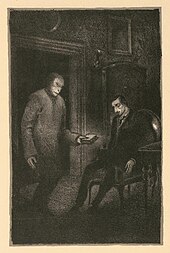The golem
The Golem is the title of a novel in twenty chapters by Gustav Meyrink . It first appeared in the years 1913 and 1914 as a serial novel in the magazine Die Weißen Blätter ; In 1915 it was published in book form. The novel is considered a classic of fantastic literature .
content

Early 20th century: The anonymous narrator of the story, visiting Prague, read a book about the life of Buddha Gotama in a book before going to bed . He falls into a restless half-sleep and slips into a dream world in which he relives events that happened more than thirty years ago in Prague's Jewish quarter .
In this state he assumes the identity of the gem cutter and restorer Athanasius Pernath, who lived in the Prague ghetto around 1890/1891 and gradually gained access to his own past, his interior, at the end of which there was an encounter with himself.
Suddenly a gentleman appears in Pernath's apartment who behaves as if he were at home there and neither greets nor takes off his hat. He pulls a tome with a metal cover out of his pocket. The initial I at the beginning of the chapter “Ibbur” (impregnation of the soul) needs to be restored. Pernath reads the mysterious Chapter I. The visitor has suddenly disappeared again like a ghost. Pernath soon suspects that the mysterious client may have been the old legendary figure, the golem , who is said to be in Prague every thirty-three years. Rabbi Löw is said to have created it from clay on the banks of the Vltava in 1580 according to the lost rules of the Kabbalah , because he wanted an assistant to protect the Jews.
From now on, the gem cutter's life gets out of hand. He is involved in numerous intrigues and haunted by hallucinations and delusions. Not only that strange things happen to him that he cannot understand. He is also embroiled in a campaign of revenge led by the medical student Charousek against the junk dealer Aaron Wassertrum, whose illegitimate son he is. He also gets to know the archivist Hillel, who is always there when Pernath needs help and with his daughter Mirjam he falls in love.
In a chamber in the neighboring house, Pernath finds a trap door and finds himself in a barred “room without access”, which he recognizes as the Golem's dwelling according to the description. A tarot game attracts his attention, especially the first card, the Pagat. He remembers drawing this map himself many years ago. Suddenly he thinks he sees himself sitting across from him in the corner of the room.
His encounters with the golem, who appears as a human doppelganger , culminate in the desire and hope to achieve a redeemed, immortal self.
As a result of a plot by the junk dealer Aaron Wassertrum, he is suspected of murder and has to go to prison, where he throws away and gives up all hope until he is unexpectedly released after six months and finds that the part of the ghetto in which he lived has been torn down . He looks in vain for his old friends. He finds a new place to stay in the house with the "room without access" which, according to the caretaker there, does not exist. When a fire breaks out in the house, he rappels down from the roof and thinks he can see Mirjam and Hillel through a window. The rope breaks and he falls on the pavement.
When the narrator wakes up again, he finds a mistaken hat with the name "Athanasius Pernath" embroidered on it. During his research he discovered further traces of the dreamed in "reality". The ending in which the narrator himself, i.e. H. his dreamed self, encountered as a doppelganger, leaves him in the dark about the reality character of the experience.
Stylistic position
Gustav Meyrink's The Golem is considered a classic of fantastic literature . The novel is not an adaptation of the Jewish Golem saga in the narrower sense, but rather an impressionistic dream against the background of the saga, which the reader is ultimately supposed to be familiar with. The title character does not appear in the novel itself; The extent to which the first-person narrator takes on the shape of the golem remains open.
filming
Contrary to some, tackling the persistent rumors, none of the three Golem Films of Paul Wegener , a film version of Meyrink's novel, not even the most famous of them, who in 1920 together with Carl Boese turned film The Golem: How He Came into the world . Rather, these films deal with the Jewish Golem saga itself, as does the film Le Golem by Julien Duvivier from 1936. Instead, however, the film "Golem" by Piotr Szulkin from 1979 is a film adaptation of the Meyrink novel.
Radio plays
The radio plays are based on the novel by Gustav Meyrink.
- 1954: The Golem - Production: BR ; Director: Friedrich Carl Kobbe , with Paul Hoffmann , Helen Hesse and Peter Ahrens , among others . Publication: CD edition: Langen Müller Audio-Books 2003
- 1964: The Golem - Production: WDR ; Director: Raoul Wolfgang Schnell , with Kurt Meisel , Wilhelm Pilgram and Walter Schmidinger , among others .
- 1996: Fantastic from Studio 13: The Golem (3 parts) - Production: SDR ; Director: Andreas Weber-Schäfer , with Felix von Manteuffel , Klaus Weiss and Ernst Konarek , among others . Publication: CD edition: Pidax Film Media Ltd. (Alive) 2017 (June)
Audio book
- The golem . Read by Wolf Euba (2003; 8 CDs)
- The golem . Read by David Nathan on audible (2009; 8:44 hours)
- The golem . Read by "Hokuspokus" on librivox - free, available online (9:02 hours)
expenditure
- The golem. Vitalis, Prague 2008, ISBN 978-3-89919-053-3 .
literature
- Sten Wistrand: Gustav Meyrink's The Golem. A Sensationalist Shlock Novel or an Esoteric Vision of the World? In: LIR.journal , No. 12 (2020), pp. 11–52.
Web links
- The Golem at Zeno.org ., Full text. Edition from 1917
- Gustav Meyrink's “The Golem” - Investigations into the narrative structure . Master's thesis by Andreas Bernhard


